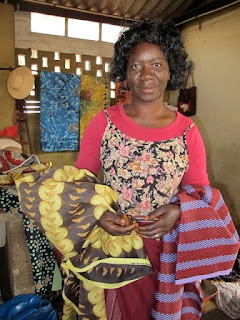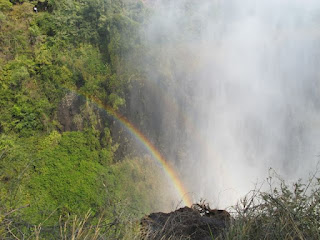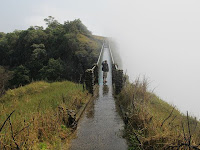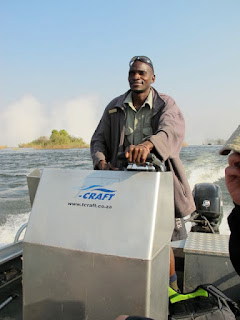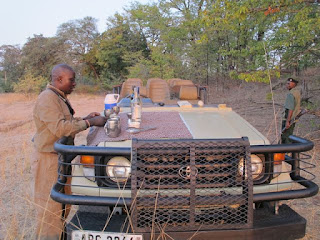 |
| Student |
July 8, 2011 Kalamu Bush Camp to Zambian Village and School
 |
| Zambian Village School |
We are surprised and delighted to climb aboard the land cruiser and find hot water bottles tucked between the heavy wool blankets. Davidson Camp, in Wenge National Park should take note of this! Our destination is to visit a local village, 20 kilometer away, outside of the confines of the park. Emanuel drives slowly looking for wild life. The vegetation at this park is mostly thornveld and broad-leaf-forest. Few of the trees and thorny scrubs are higher than 50 feet, and the terrine is dusty and dry. We pass through a scrub mopane forest, where the elephants have foraged heavily, and the mapane trees are stunted. Further on there is a forest of cathedral mopanes; I am not clear as to why the elephants have not damaged this part of the forest?
 |
| John in the classroom |
Felix is riding with us on this morning’s excursion and we soon learn that it will be his village that we are visiting. We are on a private tour with three men from the camp; Emanuel, our guide, James, our protector, and Felix, our host to the village. We pass from the park into public land and over a wide dry riverbed. Two women are doing laundry with a half dozen children in tow. The women have dug down through the sand to reach the clean water below and pound laundry through the holes they have dug. (when, we return three hours later, they are still there, with their laundry spread colorfully to dry, like a patchwork quilt, over the compacted sand of the dry riverbed.) I desperately want to take photos, but refrain out of respect. Their village is up on the plateau, not far from the river, a collection of small, round, mud-brick shelters, with thatched roofs. We wave and continue on another 20 minutes until we come to three small structures, the village school. Emanuel pulls the Toyota Land Cruiser into the circular dirt driveway and we climb out to visit the classrooms.
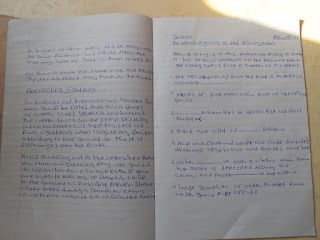 |
| A+ Workbook |
The school is from 1st grade to 7th grade, and there are three classrooms with a morning and afternoon session. We meet the head teacher who wears a dark suit, dusty and wrinkled, but very impressive; especially after having just witnessed the laundry facilities available. After introductions and hand-shakes, we enter his classroom and the 8 or 9 students snap to attention. The students share 4 desks in the classroom, and each is working in a neatly printed workbook. Plastic orange chairs are stacked at the side of the room and the large blackboard is neatly printed, with what I assume is today’s lesson. We gravitate over to one boy who has his workbook open. His printing is precise and the English perfectly composed. John stares in amazement at this, grins and tells the boy that his writing isn’t nearly as good. The boy is working on questions concerning the benefits and disadvantages of mining in parts of Zambia. We walk around the room, introduce ourselves and compliment the work. Felix watches from the open doorway of the classroom; two of the girls in this school are his daughters. The 6th grade classroom is across the drive in a mud brick building; built by Wilderness Safari’s. Once again, the children snap to attention; we share introductions and they show us drawings that they completed yesterday. I ask if I may take photos; affirmative, and I take many of the students who seem especially delighted to have their photos taken with John.
 |
| Proud Students |
 |
| Village Classroom |
We drive another 5 or 6 kilometers, past several small village compounds to Felix’s village. 15 or 20 children rush to greet us at the road and seeing the camera around my neck, beg me to take photos of them. They pile in front of each other, pushing and shoving and making it difficult to take photos, but I am very happy to oblige. After each series of clicks, I bend down to show them the images in the back of my camera and my balance is offset as they crowd around, wide eyed and curious, immediately begging for more photos. A few of the children are rolling bicycle tires with sticks or riding discarded automobile tires; all look happy and healthy, and all are bare foot and dusty. The hair of most of the girls is elaborately tied in corn rows and one of the girls is carrying her baby sister on her back. Alice is a petite, precocious, 11 year old and quietly introduces herself to me. Her sister is 2 and tied upon her back with a colorful band of cloth.
 |
| Alice carrying her sister |
We follow Felix into his village, which is really his extended family compound.
 |
| Zambian Village |
There are 5 thatched, rectangular, mud brick houses, each with two small rooms; a sitting room and a sleeping room. There are numerous smaller out buildings for storage, bathing and toilet facilities. We meet Felix’s grandfather, sitting in a swept back compound. He is 80 years old, with a gnarled face as black as ebony. I tell him that my father is 94 and he tells me, via Felix’s interpretation, that he must then be young! A very pregnant woman stands in the doorway behind the grandfather. She looks to be in her early 30’s and I stupidly ask her if this is her first? She grins and tells me it will be her 8th. Felix jokes that she may be having twins, but she tells me that is not the case; that she goes each month to the doctor at the clinic and is pregnant with just one child. I ask if she will have the baby at home, and she tells me that she will go to the hospital to have her baby. Later, I question Felix how she will travel the 8 kilometers to the hospital and he tells me that her husband will take her there by bicycle, when she feels that it is time.
 |
| Girl Watching |
 |
| Village Children |
 |
| Children Playing |
 |
| John with village children |
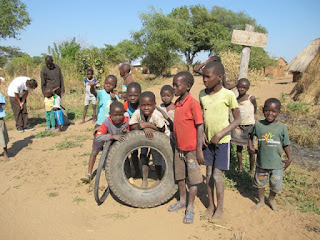 |
| Going to the well |
We meet Felix’s wife, a wiry, small featured woman carrying someone else’s baby in her arms. She is not forthcoming and I am sure that she is quite fed up with having visitors to her family compound on the Wilderness Safari, excursion list. Another, more gregarious woman is tending a still, making corn liquor over a fire. We are shadowed by the children as we walk across the road to the well, a modern, pump system, where they fetch clean drinking water. I inquire why there are no teen age children in the village, and am reminded that they are still in school; that the younger children will attend school in the afternoon.
I desperately need to use the bathroom and gather my courage to ask if I may use their toilet, or if I should wait until we are in the bush? I am welcome to use their outhouse and am pointed in the direction of two small out buildings. The first one I choose is the shower room, a piece of corregated metal placed upon the dirt floor, with several empty plastic containers set to the side. Beside this out building is the outhouse and I step in, close the corregated metal door and survey the facilities. It is immaculate and bare except for a 6” raised oval “seat,” sculpted of red mud.
 |
| Woman mud plastering her house |
 |
| Curious Villagers |
We leave Felix in his compound and drive 15 minutes down the road to visit another village. We will pick him up on our return and I surmise that this second village visit is correographed to allow Felix, time alone with his wife. These village excursions may actually be a welcome diversion for the guides; and Felix is fortunate, his village being in close proximity to our camp. Most of the guides and camp staff work 59 days straight with two weeks off to return home.
The road we are driving is a single track dirt road and we pass a mud quarry and wave to a man who is cutting mud for bricks. Further on, we pass a field of tall grass and wave to another man, harvesting the grass to be dried and used for the thatched roofs. These men are the friends and family members of our guides and by association, we also wave and feel at ease. We park our land cruiser at the next village and enter the compound. A young man in his mid 20’s in the process of building a traditional, two room, mud brick house. He shows us the form that he uses to make the bricks and points to a large pile of bricks off to the edge of the compound, waiting to be fired. Beside the unfinished house, is a 15 foot stack, of thatch grass and he seems genuionly pleased to show us his work in progress. A woman about my age, hands thick with wet red mud, walks towards us. I extend my hand in an offered handshake and she extends her less muddy hand, grins and leads us to the other side of her house, pointing to the bucket of mud that she is applying to an exterior wall, cementing in the cracks. The news of our presence has reached the children and I feel like the Pied Piper as they follow us, pointing to themselves and then to my camera, crowding and pushing their playmates out of the way as I take their photos. They giggle and push close to me when I kneel down to show them their captured images in the back of my camera.
 |
| Saying Goodbye |
We retrace our tracks, pick Felix up at his village and head back to our camp. The women from the first village are still gathered in the dry river bed, their washed laundry spread along the sand to dry. Several of the small children sit naked; I surmise having just bathed in the excavated holes of fresh water, dug for wash day. I ask Emanuel if this village has a well but they do not, and it is many kilometers to the pump well adjoining his village; here they must get their clean drinking water from the river- bed, by digging down where the water is filtered clean by the sand.
When we pass back into the national park, we stop briefly for tea, alongside of the park guard house. A woman sits outside, braiding a young girl’s hair. A tiny child of about two, appears from nowhere, runs up and hugs the legs of James, our silent guardian with the ever ready rifle. It is his daughter and when I ask him where his wife is, he points off into the distant scrub forest and pulls out a cell phone.
We get back to the camp at 12:30 P.M.; 1 ½ hours late for brunch, but they have held lunch for us and we enjoy omletts to order, bacon, sausage and fresh salad.
We leave for our afternoon game drive at 4:00 P.M. following an afternoon tea of lemon cake and tea sandwiches. We are becoming jaded by the plentiful impala, and the puku antelope, which are unique to this region. We spot grysbok and bush bucks and the usual assortment of birds, yellow baboons and velvet monkeys. As the sun dips towards the horizon, Emanuel puts the vehicle in 4 wheel drive, jostling us over to a grassy embankment, overlooking the hippo infested river. We drink our sundowners watching the hippos in the river move closer towards our embankment. Twelve hippos sneeze, spout, grunt and yawn, watching us and listening with twitching ears. It is obvious that as dusk settles in they are anxious for us, the intruders, to move on, so that they can climb up onto the bank and move inland for their nightly grazing. We are parked on their well worn, “hippo highway.”
When day turns to night, Emanuel drives with one hand, scanning the underbrush of the forest with a spotlight. As we drive between the forest and the grass lands, I note extreme temperature difference and understand why many of the animals take shelter in the forest after dark. I too prefer the warmth and spicy aromas of the forest to the open plains. Tonight, the animals seem to have gone on holiday and we see little but then Emanuel stops, gets out and reaches high into a scrubby bush. He returns to the vehicle holding a flapped skinned chameleon. We are delighted and amazed that he was able to spot this camoflaged, 8 inch reptile. As we hold it, it changes from solid emerald green to variegated green and black and we examine its remarkable rotating eyes and unusual feet. Emanuel carefully tucks it far back into the bush where it came from and we drive back towards camp.
4 other guests have arrived today, in two private Cessna airplanes. It is a family from South Africa; mother, father and their adult son and daughter in law. We are happy to have the company and conversation of this group during a, not so remarkable, dinner of cream of tomato soup, fish sticks wrapped in bacon, veggies and rice. After dinner, we visit briefly around the fire, returning to our cabin early, in anticipation of another full day tomorrow.













